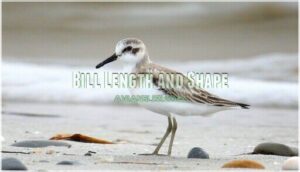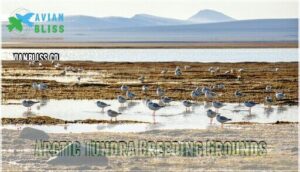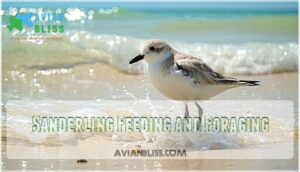This site is supported by our readers. We may earn a commission, at no cost to you, if you purchase through links.

During winter, they’re dressed in simple gray and white, but breeding season brings striking rufous patches.
These robin-sized birds probe wet sand for tiny crabs and marine worms, often gathering in large flocks during migration.
Sanderlings are marathon travelers, nesting in Arctic tundra before flying thousands of miles to wintering beaches from California to South America.
Their missing hind toe makes them unique among sandpipers, perfectly adapted for their beach-running lifestyle and specialized feeding techniques, which include their ability to survive in a variety of environments, making them successful wintering birds in many parts of the world, including South America.
Table Of Contents
- Key Takeaways
- Sanderling Physical Traits
- Sanderling Behavior Patterns
- Sanderling Habitat and Migration
- Sanderling Feeding and Foraging
- Sanderling Conservation Status
- Frequently Asked Questions (FAQs)
- Is a Sanderling the same as a sandpiper?
- What is the behavior of a Sanderling?
- How do you identify a Sanderling?
- What is another name for a Sanderling?
- What’s the difference between a sandpiper and a Sanderling?
- What is the meaning of Sanderling?
- How long does a Sanderling live?
- How long can sanderlings live?
- Do sanderlings have any natural predators?
- What are the distinct vocalizations of sanderlings?
- Conclusion
Key Takeaways
- You’ll recognize sanderlings by their unique three-toed feet and stout, straight black bill – they’re the only sandpipers missing a back toe, which makes them perfect wave-chasing specialists.
- Watch for their distinctive "wind-up toy" behavior as they frantically chase waves back and forth along sandy beaches, timing their runs perfectly with retreating surf to snatch crabs and marine worms.
- You can spot dramatic seasonal changes in their appearance – pale gray and white in winter, transforming to striking rusty-red breeding plumage on their heads, necks, and backs during summer months.
- These marathon migrants travel up to 44,000 kilometers annually between Arctic tundra breeding grounds and wintering beaches from California to South America, making them one of the world’s most widespread shorebirds.
Sanderling Physical Traits
You’ll recognize a Sanderling by its compact, plump body measuring 7-8 inches long with a distinctive stout, straight black bill that’s about as long as its head.
What makes this little shorebird truly unique is its missing back toe—an adaptation that turns it into a beach-running specialist, letting it sprint after waves like a feathered race car, with its ability to move quickly being a key factor in its survival, making it a feathered race car.
No back toe, all speed — nature’s perfect wave-chasing machine.
Size and Measurements
Every sanderling you’ll spot measures roughly 7-8 inches long, weighing between 1.4-3.5 ounces—about the size of a dunlin but smaller than a red knot.
These compact shorebirds pack surprising heft into their plump frames, making them perfect wave-chasers.
- Bill Length: Stout, straight bill equals head length for efficient sand probing
- Body Mass: Weight varies seasonally from 40-100g depending on migration fuel stores
- Wing Span: 13.8-inch wingspan provides powerful flight for Arctic-to-tropics journeys
- Leg Size: Short, sturdy black legs built for rapid beach sprinting
- Feather Depth: Dense plumage creates rounded silhouette distinguishing them from slimmer peeps
Color Patterns
Sanderlings transform like chameleons throughout the year, showcasing dramatic plumage shifts.
During breeding season, you’ll spot rich rusty tones across their necks and backs, creating a warm, earthy palette.
Winter brings a complete makeover—pale feathers dominate, giving them an almost ghostly frosty appearance.
This seasonal wardrobe change helps them blend seamlessly into different environments, aided by their ability to adapt like chameleons.
Breeding Vs Non-breeding Plumage
Throughout winter and into spring, you’ll witness nature’s most dramatic makeover as sanderlings transform from their pale, ghostly winter appearance to vibrant breeding colors.
This remarkable plumage change happens twice yearly through feather molting, creating distinct seasonal looks that’ll help you identify these birds year-round.
Key plumage differences to watch for:
- Winter plumage – Clean white underparts with pale gray backs, earning them their "frosty appearance" nickname
- Breeding plumage – Rich rusty tones on head, neck, and upperparts with distinctive reddish-brown patches
- Transitional phases – Mixed coloring during spring and fall migrations when old and new feathers overlap
These color patterns serve as nature’s calendar, with breeding cycles driving the timing of each molt.
Males often develop more intense rusty tones during mating displays, making them easier to spot among flocks.
Bill Length and Shape
You’ll recognize a Sanderling by its stout, straight bill that’s roughly the same length as its head.
This bill thickness sets it apart from thinner-billed relatives like Least Sandpipers. The bill structure perfectly suits their wave-chasing lifestyle.
Understanding the importance of beak adaptations is vital in identifying different bird species.
| Feature | Sanderling | Dunlin | Least Sandpiper |
|---|---|---|---|
| Bill Length | Head-length | Slightly curved | Shorter, thin |
| Bill Thickness | Stout, robust | Medium width | Very thin |
| Beak Shape | Straight, blunt | Slightly drooped | Needle-like |
| Mouth Size | Wide gape | Moderate gape | Small gape |
| Jaw Alignment | Even upper/lower | Slight overbite | Precise alignment |
The table highlights the distinct characteristics of each species, including bill length, bill thickness, and beak shape, which are crucial for identification.
By examining these features, particularly the mouth size and jaw alignment, one can accurately distinguish between Sanderlings, Dunlins, and Least Sandpipers, making bird species identification more accessible.
Leg Structure and Toe Arrangement
Beyond the bill, you’ll notice sanderling leg anatomy differs dramatically from other shorebird species.
These small waders lack a hind toe—a unique foot structure that transforms them into beach-running specialists. Their ankle movement stays fluid while chasing waves.
Here are 5 key leg features that make sanderlings masters of sandy terrain:
- Three-toe design – Missing hind toe reduces drag when sprinting across wet sand
- Black, sturdy legs – Proportionally shorter than other sandpipers for quick direction changes
- Flexible ankle joints – Allow rapid pivoting while following retreating waves
- Wide toe spread – Distributes weight evenly on soft surfaces in bird habitat
- Strong leg muscles – Power their signature "bicycling" motion through surf zones
This specialized toe arrangement gives sanderlings their wind-up toy appearance as they dart along shorelines.
Sanderling Behavior Patterns
You’ll recognize Sanderlings by their signature wave-chasing dance, where they sprint back and forth like mechanical toys following each surge of water.
These energetic shorebirds spend their days probing wet sand for crabs and marine worms, often forming busy flocks that move as one coordinated feeding unit.
Running and Chasing Waves
Watch this small wader break free from ordinary bird behavior. The sanderling masters Wave Chasing like no other shorebird species.
Nature’s most graceful wave dancer turns every shoreline into a mesmerizing performance of pure coastal magic.
You’ll spot their signature Beach Sprint along shorelines, legs pumping in perfect rhythm with retreating waves. This migratory bird’s Surf Running creates a mesmerizing dance of Coastal Racing and Tide Foraging that defines coastal wildlife encounters.
The sanderling’s ability to engage in effective wave chasing gear is a key factor in its unique behavior.
| Behavior | Speed | Wave Timing |
|---|---|---|
| Beach Sprint | Quick bursts | Retreats with surf |
| Coastal Racing | Rapid steps | Follows wave edges |
| Tide Foraging | Stop-and-go | Matches water movement |
Probing Sand and Mud for Prey
When you’re watching a sanderling work the shoreline, you’ll notice how methodically it uses its stout bill for sand probing and mud foraging.
This sandpiper’s prey capture technique involves precise timing and specialized movements:
- Bill insertion: Pushes its straight bill deep into wet sand
- Tactile sensing: Feels for buried invertebrates through sensitive bill tip
- Rapid extraction: Quickly pulls out marine worms and small crustaceans
- Surface gleaning: Picks visible prey from exposed sediment surfaces
This coastal wildlife demonstrates remarkable efficiency in shorebird habitat exploitation.
Feeding on Sand Crabs and Invertebrates
You’ll spot sanderlings targeting sand crabs with laser-like focus during their wave-chasing runs.
These nimble shorebirds excel at crab predation, snatching mole crabs and other invertebrates as waves retreat.
Their invertebrate diet includes amphipods, marine worms, and small mollusks.
This surf foraging strategy maximizes prey capture efficiency, turning each wave cycle into a feeding opportunity that fuels their incredible migrations.
Flocking and Social Behavior
You’ll often see Sanderlings forming dynamic flocks that shift like liquid mercury across beaches.
These social birds gather in groups ranging from dozens to thousands, constantly communicating through soft peeps and visual cues while coordinating their wave-chasing activities.
Flocking behaviors that’ll capture your heart:
- Safety in numbers – Large flocks create multiple eyes watching for predators while individuals focus on feeding
- Synchronized movement – Groups flow together like a single organism, turning and running in perfect unison
- Information sharing – Birds learn prime feeding spots by following successful flock members to productive foraging areas
Flock Dynamics reveal how these shorebirds balance individual needs with group benefits.
Social Bonds aren’t permanent pair relationships but temporary alliances that maximize survival.
Group Size varies seasonally, with massive winter congregations splitting into smaller breeding units.
Their Communication Patterns include subtle head movements and calls that coordinate flock movement, making their social behavior a masterclass in collective intelligence.
Territorial Defense and Aggression
During breeding season, you’ll notice sanderlings become surprisingly scrappy defenders of their Arctic turf.
Males engage in agonistic behavior through threat displays—puffing feathers, spreading wings, and making aggressive calls toward intruders.
Their territorial defense involves border patrols around nesting sites, establishing a clear dominance hierarchy among competing birds.
This bird aggression intensifies when resources are scarce, transforming these usually peaceful shorebirds into feisty territorial warriors protecting their breeding grounds.
The sanderlings’ behavior is a prime example of territorial defense strategies that help them maintain control over their territory and resources.
Sanderling Habitat and Migration
You’ll find Sanderlings on sandy beaches and mudflats across every continent except Antarctica, making them the world’s most widespread shorebird.
These remarkable birds travel thousands of miles between their Arctic breeding grounds and wintering coasts, relying on critical stopover sites to refuel during their epic journeys.
Sandy Beaches and Coastal Mudflats
You’ll find sanderlings scattered across sandy beaches and coastal mudflats where tidal patterns create perfect feeding conditions.
These migratory birds thrive in coastal ecosystems that offer rich mudflat dynamics and diverse prey.
Key habitat features include:
- Wave-washed sandy shores – ideal for chasing retreating surf
- Exposed mudflats during low tide – prime probing territory
- Protected bays and estuaries – essential stopover sites during bird migration
This sandpiper species depends on healthy shoreline management and beach ecology for survival.
Arctic Tundra Breeding Grounds
When you’re tracking Sanderlings through the seasons, you’ll discover they escape winter’s grip by heading to the Arctic tundra for breeding.
This harsh landscape becomes their nursery from June through August, where they’ll sport their striking breeding plumage—rusty-red necks and backs that make them unmistakable against the stark tundra backdrop.
These Arctic nesting sites offer the perfect Tundra Ecology: wet areas for foraging insects while dry, stony ground provides safe nesting spots.
Their Breeding Habits are perfectly timed with the brief Arctic summer.
Long Distance Migration Routes
Sanderlings undertake epic journeys spanning up to 44,000 kilometers annually across multiple continents.
These remarkable birds use three major flyways: Atlantic, East Atlantic, and Pacific routes. You’ll witness incredible endurance as they navigate from Arctic breeding grounds to wintering sites in South America, Africa, and Australia.
Migration marvels that’ll leave you speechless:
- Single birds can fly nonstop from Iceland to northern Canada without landing
- Some individuals travel further than the distance from Earth to the moon over their lifetime
- Arctic populations mix freely across continents—birds from the same breeding area may winter thousands of miles apart
- Young sanderlings maintain the same migration route they learned as juveniles for their entire lives
- West African routes show lower survival rates, proving migration choice can be life-or-death
Understanding Sanderling migration patterns is essential for conservation efforts.
Stopover Sites and Refueling
During their epic journeys, you’ll discover these birds can’t just fly non-stop. They need pit stops to pack on the pounds. At key stopover sites, sanderlings gain up to 4% of their body weight daily, fueling up for the next leg of their migration patterns.
Understanding shorebird migration is essential for conservation efforts.
| Major Stopover Sites | Key Features | Conservation Priority |
|---|---|---|
| Delaware Bay | Horseshoe crab eggs provide rapid energy reserves | Critical habitat protection |
| Wadden Sea | Abundant invertebrates support refueling strategies | International cooperation needed |
| Yellow Sea | Supports 12% of global population during peak migration | Urgent conservation action required |
These refueling strategies aren’t just impressive—they’re life-or-death. Bird conservation efforts focus heavily on protecting these stopover ecology hotspots, since losing even one major site could crash entire populations.
The feeding behavior at these locations transforms scrawny travelers into fat-loaded fliers ready for their next thousand-mile stretch.
Global Distribution and Range
You’ll spot sanderlings on coastlines across every continent except Antarctica.
Their global range spans from Arctic breeding grounds in North America, Greenland, and Siberia to wintering sites reaching Chile and Argentina.
This remarkable distribution makes them the world’s most widespread shorebird, with migration patterns covering thousands of miles between breeding grounds and diverse wintering coastlines.
The sanderlings’ ability to thrive in various habitats is influenced by factors similar to those affecting wood stork range and migration patterns.
Sanderling Feeding and Foraging
You’ll find sanderlings are master foragers with a diet that changes dramatically between their Arctic breeding grounds and coastal wintering areas.
Watch them chase retreating waves like mechanical toys, expertly timing their runs to snatch sand crabs and marine worms from freshly exposed sand, showcasing their ability as mechanical toys.
Diet Composition and Prey Preferences
Diet versatility keeps sanderlings thriving across diverse habitats.
You’ll spot them devouring crab prey, small crustaceans, and marine worms on beaches.
Their invertebrate diet shifts seasonally—insect feeding dominates Arctic breeding grounds while crustacean diet rules coastal wintering areas.
This adaptive marine worm diet strategy supports their incredible global migrations.
Foraging Techniques and Strategies
Mastering their craft takes skill, and sanderlings have developed remarkable foraging techniques that maximize their success along shorelines.
These energetic birds employ multiple feeding tactics to capture prey in the challenging intertidal zone environment.
Understanding the right sanderling feeder systems is essential for their survival.
- Synchronized probing – Time their sand probes with wave retreats to catch exposed invertebrates
- Surface picking – Snatch visible prey items while running at full speed across wet sand
- Filter feeding – Use bill tips to sift through sand particles for tiny crustaceans
- Opportunistic switching – Adapt foraging behavior based on tide cycles and prey availability
Wave-Chasing and Surf-Zone Foraging
Sanderling’s wave-chasing behavior creates nature’s most entertaining beach performance.
You’ll watch these plump shorebirds dart forward as waves retreat, snatching exposed invertebrates from wet sand.
Their "bicycling" leg motion perfectly synchronizes with coastal dynamics, maximizing foraging success in the surf zone.
This intertidal zone dance requires split-second timing—too slow means missing prey opportunities.
Probing and Filtering Sand and Mud
After all that wave foraging, you’ll notice sanderlings shift gears—think of them as expert beach combers.
They use Sand Probing and Mud Filtering, poking their stout bills into wet sand to capture tiny prey.
This classic shorebird behavior helps these wading birds snag marine worms and crustaceans.
It’s a sandpiper bird’s version of a treasure hunt—Prey Capture made simple.
Scavenging and Opportunistic Feeding
If you ever spot a sanderling darting after a stray corn chip, don’t be surprised—these shorebirds are masters of food scavenging and opportunistic feeding.
On top of their usual invertebrate diet, they’ll sample human scraps and even carrion.
In the context of bird foraging, their adaptability is impressive:
- Opportunistic feeding on beaches
- Scavenging human food
- Flexible invertebrate diet
Sanderling Conservation Status
You’ll find that Sanderlings face mounting conservation challenges despite their impressive global range.
While these resilient shorebirds aren’t currently endangered, their populations show concerning declines due to coastal development and climate change threatening their beach habitats.
IUCN Red List Classification
Currently, you’ll see that the sanderling holds a "Least Concern" status on the IUCN Red List, meaning it’s not facing immediate extinction risk.
This Conservation Status reflects a thorough Vulnerability Assessment that considers the species’ extensive global range and stable population.
The IUCN Red List classification provides wildlife conservation experts with critical data for Threat Evaluation.
While sanderlings aren’t endangered species today, ongoing monitoring guarantees their conservation remains effective.
Conservation efforts often rely on reviewing endangered bird lists to identify species that require immediate attention and protection.
Population Trends and Threats
Over the past 50 years, you’ll find that sanderling populations have plummeted by more than half.
Population Decline accelerates as Climate Change disrupts Arctic breeding grounds and coastal wintering areas.
Habitat Loss from development compounds these threats.
In Delaware Bay alone, numbers crashed from 425,000 in 1986 to just 115,000 by 2008.
Conservation efforts struggle against widespread migration patterns disruption.
Habitat Loss and Degradation
Coastal development threatens Sanderling survival through habitat loss and degradation.
Beach pollution from plastic debris and chemical runoff contaminates feeding areas, while coastal erosion destroys nesting sites.
Wetland destruction eliminates essential stopover habitats during migration.
Habitat fragmentation forces birds into smaller, less suitable areas, and ecosystem degradation from human activities reduces prey availability, making shorebird conservation increasingly critical.
Climate Change Impacts and Vulnerability
Climate change threatens Sanderlings like a perfect storm hitting their world.
Temperature Shifts disrupt Arctic breeding cycles while Sea Level Rise swallows coastal refuges. These Climate Refugees face shrinking options as Arctic Melting eliminates nesting sites and Coastal Erosion destroys feeding grounds.
- Arctic habitat loss: Up to 100% of breeding areas could vanish from rising temperatures
- Timing mismatches: Earlier snowmelt disrupts synchronized chick hatching with prey availability
- Coastal vulnerability: Sea level rise threatens critical migration stopover sites along shorelines
Conservation Efforts and Protected Areas
You’ll find sanderlings protected through international wildlife refuges and conservation policies spanning their global range.
Protected areas like Delaware Bay provide critical stopover habitat during migration, while habitat preservation efforts focus on maintaining sandy beaches and coastal mudflats.
Ecological restoration projects help rebuild damaged feeding areas, supporting wildlife conservation goals for these remarkable shorebirds across continents.
Conservation efforts also rely on effective wildlife conservation strategies to protect sanderling habitats, which is a key aspect of conservation policies and habitat preservation.
Frequently Asked Questions (FAQs)
Is a Sanderling the same as a sandpiper?
You’re absolutely right to wonder!
A Sanderling isn’t just "a" sandpiper—it’s a specific type within the massive sandpiper family.
Think of it like squares and rectangles: all Sanderlings are sandpipers, but not all sandpipers are Sanderlings.
What is the behavior of a Sanderling?
You’ll spot Sanderlings energetically chasing waves back and forth like mechanical toys, probing wet sand for crabs and invertebrates. They’re highly social, forming active feeding flocks.
How do you identify a Sanderling?
You’ll identify a Sanderling by its stout, straight black bill that’s roughly head-length, pale winter plumage, black legs, and distinctive wave-chasing behavior along sandy beaches.
What is another name for a Sanderling?
Like a chameleon of the shoreline, you’ll discover Sanderlings are commonly called "peeps" due to their small size and Calidris genus classification.
They’re also known as white sandpipers, reflecting their pale winter plumage.
What’s the difference between a sandpiper and a Sanderling?
Sandpipers represent a large family of shorebirds called Scolopacidae, while you’re looking at one specific species within that family.
Think of it like comparing "dogs" to "golden retrievers" – Sanderlings are actually sandpipers, just one particular type among many diverse species.
What is the meaning of Sanderling?
You’ll discover "Sanderling" means "little sand dweller" – these charming Arctic-breeding shorebirds earned their name from their beach-running lifestyle, chasing waves like feathered wind-up toys across sandy coastlines worldwide.
How long does a Sanderling live?
You’ll typically survive 6-7 years in the wild, though researchers have recorded exceptional individuals reaching 13-6 years.
Your lifespan depends on dodging predators and finding quality habitat throughout those epic migrations.
How long can sanderlings live?
Ever wonder how these tireless beach sprinters stay alive?
Sanderlings typically live 6-7 years, with some reaching 6 years maximum.
The oldest recorded individual survived at least 13 years despite facing predation and harsh coastal conditions.
Do sanderlings have any natural predators?
You’ll find that sanderlings face predation from various sources throughout their lives.
Arctic foxes, gulls, and skuas threaten eggs and chicks on breeding grounds, while raptors like peregrine falcons hunt adults during migration and winter, illustrating the constant threat of predation.
What are the distinct vocalizations of sanderlings?
Like tiny whistles echoing across windswept shores, you’ll hear sanderlings produce soft "kwick" or "kek" calls during flight and feeding.
Their vocalizations include gentle peeping notes, harsh alarm calls when threatened, and rolling trill sounds during courtship displays on Arctic breeding grounds, which feature harsh alarm calls.
Conclusion
Ready to become a sanderling expert? These remarkable shorebirds prove that adaptation drives survival success.
You’ve learned to identify their unique three-toed feet, wave-chasing behavior, and seasonal plumage changes.
Watch for their frantic surf-zone feeding and listen for their distinctive calls during migration.
Whether you spot a sanderling on Arctic tundra or tropical beaches, you’re witnessing one of nature’s most impressive long-distance travelers in action.
















